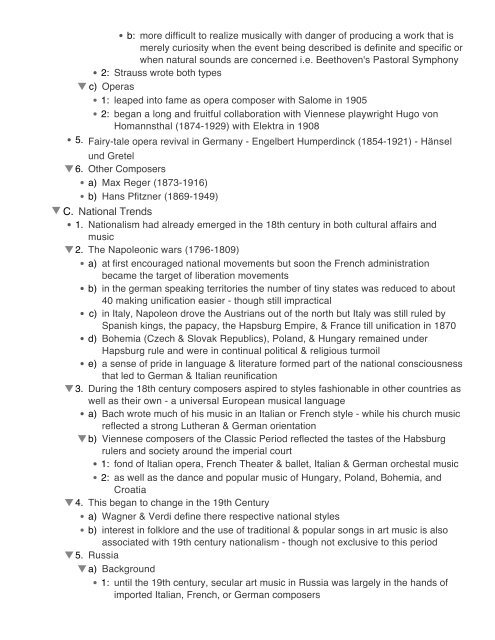An Outline of The History of Western Music Grout ... - The Reel Score
An Outline of The History of Western Music Grout ... - The Reel Score
An Outline of The History of Western Music Grout ... - The Reel Score
Create successful ePaper yourself
Turn your PDF publications into a flip-book with our unique Google optimized e-Paper software.
: more difficult to realize musically with danger <strong>of</strong> producing a work that is<br />
merely curiosity when the event being described is definite and specific or<br />
when natural sounds are concerned i.e. Beethoven's Pastoral Symphony<br />
2: Strauss wrote both types<br />
c) Operas<br />
1: leaped into fame as opera composer with Salome in 1905<br />
2: began a long and fruitful collaboration with Viennese playwright Hugo von<br />
Homannsthal (1874-1929) with Elektra in 1908<br />
5. Fairy-tale opera revival in Germany - Engelbert Humperdinck (1854-1921) - Hänsel<br />
und Gretel<br />
6. Other Composers<br />
a) Max Reger (1873-1916)<br />
b) Hans Pfitzner (1869-1949)<br />
C. National Trends<br />
1. Nationalism had already emerged in the 18th century in both cultural affairs and<br />
music<br />
2. <strong>The</strong> Napoleonic wars (1796-1809)<br />
a) at first encouraged national movements but soon the French administration<br />
became the target <strong>of</strong> liberation movements<br />
b) in the german speaking territories the number <strong>of</strong> tiny states was reduced to about<br />
40 making unification easier - though still impractical<br />
c) in Italy, Napoleon drove the Austrians out <strong>of</strong> the north but Italy was still ruled by<br />
Spanish kings, the papacy, the Hapsburg Empire, & France till unification in 1870<br />
d) Bohemia (Czech & Slovak Republics), Poland, & Hungary remained under<br />
Hapsburg rule and were in continual political & religious turmoil<br />
e) a sense <strong>of</strong> pride in language & literature formed part <strong>of</strong> the national consciousness<br />
that led to German & Italian reunification<br />
3. During the 18th century composers aspired to styles fashionable in other countries as<br />
well as their own - a universal European musical language<br />
a) Bach wrote much <strong>of</strong> his music in an Italian or French style - while his church music<br />
reflected a strong Lutheran & German orientation<br />
b) Viennese composers <strong>of</strong> the Classic Period reflected the tastes <strong>of</strong> the Habsburg<br />
rulers and society around the imperial court<br />
1: fond <strong>of</strong> Italian opera, French <strong>The</strong>ater & ballet, Italian & German orchestal music<br />
2: as well as the dance and popular music <strong>of</strong> Hungary, Poland, Bohemia, and<br />
Croatia<br />
4. This began to change in the 19th Century<br />
a) Wagner & Verdi define there respective national styles<br />
b) interest in folklore and the use <strong>of</strong> traditional & popular songs in art music is also<br />
associated with 19th century nationalism - though not exclusive to this period<br />
5. Russia<br />
a) Background<br />
1: until the 19th century, secular art music in Russia was largely in the hands <strong>of</strong><br />
imported Italian, French, or German composers<br />
2: the first composer recognized by both Europeans & Russians as an authentic<br />
native voice was Mikhail Glinka (1804-1857)





